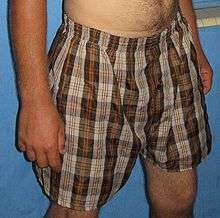Boxer shorts

Boxer shorts (also known as loose boxers or as simply boxers) are a type of undergarment typically worn by men.
The term has been used in English since 1944 for all-around-elastic shorts, so named after the shorts worn by boxers, for whom unhindered leg movement ("footwork") is very important. Boxers come in a variety of styles and design but are characterized by their loose fit.
History
In 1925, Jacob Golomb, founder of Everlast, designed elastic-waist trunks to replace the leather-belted trunks then worn by boxers. These trunks, now known as "boxer trunks", immediately became famous, but were later eclipsed by the popular Jockey-style briefs beginning in the late 1930s. Around 1947, boxer shorts started to gain in popularity again. The two styles, briefs and boxer shorts, had varying ratios of sales for the following forty years, with strong regional and generational preferences.
In more recent decades, boxer shorts got a fashion boost in 1985 when English model and musician Nick Kamen stripped to white Sunspel boxers in a 1950s style "Launderette" in a Levi's commercial.[1][2] Since the 1990s, some men also opt for boxer briefs as a compromise between the two.
Design

Most boxer shorts have a fly in front. Boxer shorts manufacturers have a couple of methods of closing the fly: metal snaps or a button or two. However, many boxer shorts on the market do not need a fastening mechanism to close up the fly as the fabric is cut and the shorts are designed to sufficiently overlap and fully cover the opening. This is commonly known as an open fly design.
Since boxer shorts fabric is rarely stretchy, a "balloon seat", a generous panel of loosely fitting fabric in the center rear of the shorts, is designed to accommodate the wearer's various movements, especially bending forward. The most common sewing design of boxer shorts are made with a panel seat that has two seams running on the outer edges of the back seating area, creating a center rear panel. Most mass-produced commercial boxer shorts are made using this design.

Two less common forms of boxer shorts are "gripper" boxers and "yoke front" boxers. Gripper boxers have an elastic waistband like regular boxers but have snaps, usually 3, on the fly and on the waistband so that they open up completely.

Yoke front boxers are similar to gripper boxers in that the wide waistband yoke can be opened up completely, and the yoke usually has three snaps to close it while the fly itself, below, has no closure mechanism. There are two types of yoke boxers: one in which there is a short piece of elastic on each side of the waistband which snugs up the yoke to fit the waist; and "tie-sides" which have narrow cloth tapes on each side of the waist yoke, like strings, which are tightened and knotted by the wearer to make an exact fit. This style of underwear was very common during World War II, when the rubber needed for elastic waistbands had to be used for military purposes.
Boxer shorts are available in white and solid colors including pastels, and come in a variety of patterns and prints as well; Traditional patterns include "geometrics" (small repeating geometric designs), plaids and vertical stripes. Additionally, there are innumerable "novelty" boxer short patterns. Boxer shorts are produced using various fabrics including all cotton, cotton/polyester blends, jersey knits and silk.
Fertility
Some studies have suggested that tight underwear and high temperature are not optimally conductive for sperm production. The testicles are outside the body for cooling because they operate for sperm production at a slightly lower temperature than the rest of the body, and boxer shorts allow the testicles to operate within the required temperature range. The compression of the genitals in briefs may cause the temperature to rise and sperm production to fall. There is a similar theory regarding testicular cancer risk.[3] Other sources dispute this theory. A study in the October 1998 Journal of Urology, for example, concluded that underwear type is unlikely to have a significant effect on male fertility.[4]
Boxer shorts for females
Girl boxers have come onto the market in recent years. They are often worn as loungewear. They differ from boyshorts in that they are commonly longer and more closely resemble their male counterparts.
In popular culture
In 1975, a Sears catalog photo of boxer shorts created a recurring urban legend.[5] A model appeared to have part of his penis exposed in the photo, which a Sears spokesperson stated was a printing defect.[6] Despite widespread press interest at the time, Sears reported that only a few letters were received from the general public, and noted that when the image was reprinted in the Spring-Summer catalog, it showed no such flaw.[5][6][7] No recall of the catalog occurred.[8] The incident inspired the singer Zoot Fenster's 1975 single "The Man on Page 602".[6]
See also
References
- ↑ "I Love 1986 – Fashion – Boxer Shorts". British Broadcasting Corporation. Retrieved 2008-05-09.
- ↑ "About Sunspel". Sunspel Journal.
- ↑ "Diurnal scrotal skin temperature and semen quality". Reproductive Toxicology. Sanger & Friman. 1990. pp. 229–232.
- ↑ A critical analysis of the role of underwear type in male subfertility
- 1 2 Kunz, Marji (13 October 1975). "Catalog Rumours Just That". The Evening Independent. Knight Newspapers. Retrieved 19 December 2014.
- 1 2 3 Cole, Shaun (2012). The Story of Men's Underwear. New York: Parkstone International. p. 98. ISBN 978-1-78042-882-6.
- ↑ Staff writer (18 September 1975). "Sears Ad on Shorts Hot Item". The Reading Eagle. Associated Press. Retrieved 19 December 2014.
- ↑ Lacitis, Erik (13 June 1997). "Rumors? Erik Sets The Record Straight". The Seattle Times. Retrieved 19 December 2014.
External links
| Look up boxer shorts in Wiktionary, the free dictionary. |
| Wikimedia Commons has media related to Boxer shorts. |